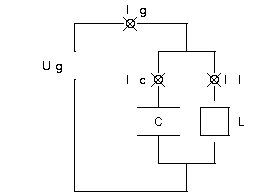0.0.1 ↑ 60. Hausaufgabe
0.0.1.1 ↑ Wechselstromkreisanalyse

- Wechselstromwiderstände von Kondensator und Spule
R_{C_\omega} = \frac{1}{\omega C};
R_{L_\omega} = \omega L;
\omega_0 = \frac{1}{\sqrt{L C}};
\hat U_G = \sqrt{2} \, U_{G_{\text{eff}}};
- Terme für den Gesamtwiderstand und die Ströme I_{G_\omega}(t), I_{C_\omega}(t), I_{L_\omega}(t)
⇒ R_\omega = \dfrac{1}{\frac{1}{R_{C_\omega}} + \frac{1}{R_{L_\omega}}} = \dfrac{\omega L}{\omega^2 L C + 1};
⇒ I_{G_\omega}(t) = \frac{U_{G_\omega}(t)}{R_\omega} = \hat U_G \sin \omega t \cdot \frac{\omega^2 L C + 1}{\omega L};
⇒ I_{C_\omega}(t) = \frac{U_{G_\omega}(t)}{R_{C_\omega}} = \hat U_G \sin \omega t \cdot \omega C = \underbrace{\hat U_G \cdot \omega C}_{\hat I_{C_\omega}} \cdot \sin \omega t;
⇒ I_{L_\omega}(t) = \frac{U_{G_\omega}(t)}{R_{L_\omega}} = \hat U_G \sin \omega t \cdot \frac{1}{\omega L};
- Grenzwertbetrachtungen
Betrachtung des Gesamtwiderstandes R_\omega:
\lim\limits_{\omega \to 0 \frac{1}{\mathrm{s}}} R_\omega = 0 \,\Omega; (Einsetzen)
\lim\limits_{\omega \to \infty \frac{1}{\mathrm{s}}} R_\omega = 0 \,\Omega; (Grad des Polynoms des Zählers kleiner als der des Nenners)
R_{\omega_0} = \dfrac{L}{\sqrt{L C} \left(\frac{1}{LC} LC + 1\right)} = \sqrt{\frac{L}{2 C}};
Anschaulich: Bei \omega \to 0 \frac{1}{\mathrm{s}} liegt Gleichstrom vor; der Kondensator leitet also gar nicht und die Spule ideal. Bei \omega \to \infty \frac{1}{\mathrm{s}} leitet die Spule gar nicht und der Kondensator ideal.
Betrachtung des Stroms durch den Kondensator C_{L_\omega}(t):
\lim\limits_{\omega \to 0 \frac{1}{\mathrm{s}}} I_{C_\omega}(t) = 0 \,\mathrm{A}; (Einsetzen)
Bei Gleichstrom ist der Kondensator ein Nichtleiter, I_{C_\omega}(t) ist Null.
\lim\limits_{\omega \to \infty \frac{1}{\mathrm{s}}} I_{C_\omega}(t) ist nicht definiert (Sinus konvergiert nicht). Stattdessen Betrachtung von \hat I_{C_\omega}:
\hat I_{C_\omega} = \hat U_G \cdot \omega C \to \infty \,\mathrm{A} für \omega \to \infty \frac{1}{\mathrm{s}};
I_{C_{\omega_0}}(t) = \hat U_G \sin \sqrt{\frac{t^2}{LC}} \cdot \sqrt{\frac{C}{L}};
Betrachtung des Stroms durch die Spule I_{L_\omega}(t):
\lim\limits_{\omega \to 0 \frac{1}{\mathrm{s}}} I_{L_\omega}(t) = \lim\limits_{\omega \to 0 \frac{1}{\mathrm{s}}} \frac{\hat U_G}{L} \frac{\sin \omega t}{\omega} = \lim\limits_{\omega \to 0 \frac{1}{\mathrm{s}}} \frac{\hat U_G}{L} \frac{\sin \omega t}{\omega t} \cdot t = \frac{\hat U_G}{L} \cdot t; (\lim\limits_{x \to 0} \frac{\sin x}{x} = 1)
Damit nimmt der Strom proportional mit der Zeit zu. Dies entspricht unseren Erwartungen: Da die Spule bei Gleichstrom (\omega \to 0 \frac{1}{\mathrm{s}}) ein idealer Leiter ist, ist ihr Widerstand Null und damit geht der Strom für t \to \infty \,\mathrm{s} gegen Unendlich.
\lim\limits_{\omega \to \infty \frac{1}{\mathrm{s}}} I_{L_\omega}(t) = 0 \,\mathrm{A}; (Zähler "schwankt" zwischen -\hat U_G und \hat U_G, Nenner geht gegen Unendlich)
Die Spule ist bei "unendlich frequenten" Wechselstrom ein Nichtleiter.
I_{L_{\omega_0}}(t) = \hat U_G \sin \sqrt{\frac{t^2}{LC}} \cdot \sqrt{\frac{C}{L}};
- Abschließende Bemerkungen
Im Resonanzfall ist I_{C_{\omega_0}}(t) für alle Zeitpunkte t gleich I_{L_{\omega_0}}(t)!
- Graph des Gesamtwiderstandes in Abhängigkeit von \omega

Interessant ist, dass der Gesamtwiderstand bei \omega = \sqrt{\frac{1}{C}} ist (ermittelbar durch den Ansatz R_\omega' = 0 \frac{\mathrm{Vs}}{\mathrm{A}}). Dieses \omega ist nicht von L abhängig!
- Graph der maximalen Generatorstromstärke in Abhängigkeit von \omega

Interessant ist, dass die Scheitelstromstärke des Generators bei \omega_0 minimal ist (ermittelbar durch den Ansatz \hat I_{G_\omega}' = 0 \,\mathrm{C}).
- Graph der maximalen Energie in Abhängigkeit von \omega
E_{\text{max}_\omega} = E_{L_{\text{max}_\omega}} + E_{C_{\text{max}_\omega}} = \frac{1}{2} L \omega^2 \cdot \hat Q^2 \cos^2 \omega t + \frac{1}{2} \frac{1}{C} \cdot \hat Q^2 \sin^2 \omega t = \frac{1}{2} \hat Q^2 \left(\cos^2 \omega t + \sin^2 \omega t\right) \left(L \omega^2 + \frac{1}{C}\right) = \frac{1}{2} \hat Q^2 \left(L \omega^2 + \frac{1}{C}\right);
Also nimmt der maximale Energieinhalt mit größer werdendem \omega zu; es ergibt sich kein Umkehrpunkt.

(Benötigte Zeit: 140 min)